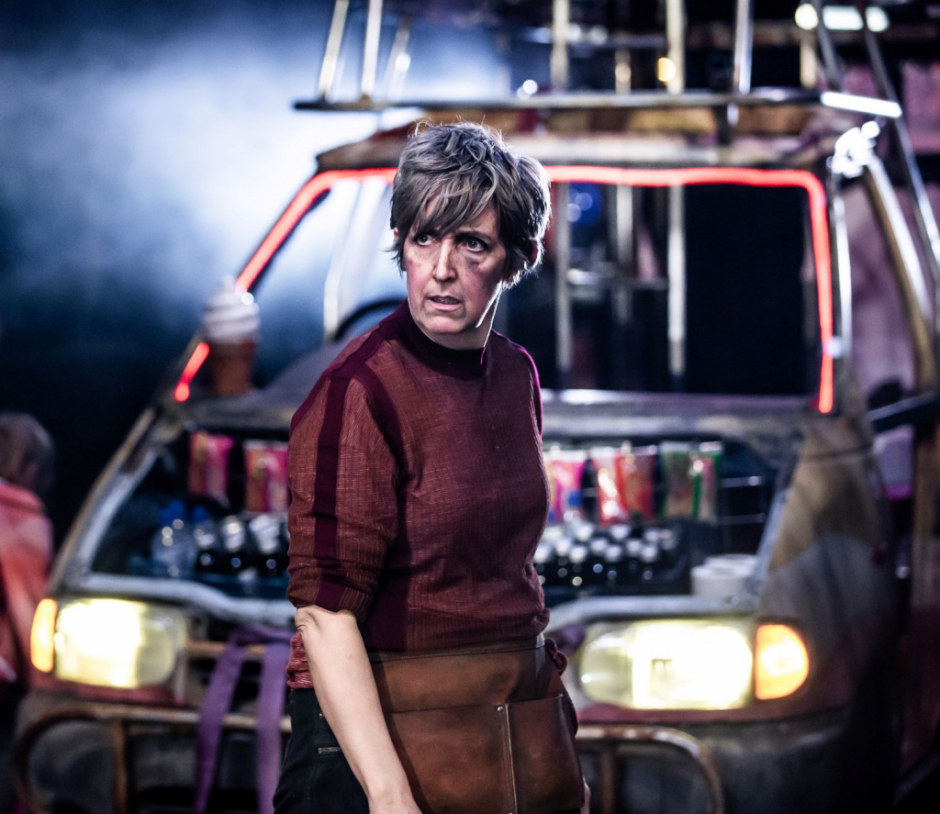Mother Courage and her Children | Royal Exchange | 8 FEBRUARY 2019 – 2 MARCH 2019
Mother Courage and her children are transported into the future in a new co-production from the Royal Exchange and Headlong. By setting her adaptation in 2080, Anna Jordan breathes new life into Brecht’s acclaimed anti-war play, demonstrating its 21st century relevance.
Joanna Scotcher’s dazzling set and costume design enhance the dystopian landscape. Hedydd Dylan, who plays Yvette, a young woman from whose prostitution Mother Courage profits, offers an unsettling depiction of sexualised femininity. Dylan’s provocative garb contrasts starkly with Julie Hesmondhalgh’s androgynous look. These costumes highlight the play’s most poignant themes: the commodification of women and female vulnerability. Hardened by war, Mother Courage has shed all outward signs of femininity in order to protect herself.
The most impressive costume undoubtedly belongs to Mother Courage’s ‘fourth child’: a repurposed ice cream van. After its first appearance as a beaten-up vehicle with a burnt-out engine, dragged by the children as Mother Courage sits at the wheel, the van undergoes a series of transformations which reflect Mother Courage’s changes in fortune. It shifts from a semi-functional container, with Courage’s wares neatly hidden from the sight of the authorities, in the first act, to pimped-up party bus in the second act. As the war rages around her, and Courage suffers the loss of her children, her brazen attitude and lucrative business are reflected in the van’s upgrades, as it becomes increasingly adorned and brightly illuminated, before falling into disrepair as her fortunes fade.
The futuristic set design contrasts with the rough cardboard signs which hang above the stage. Their primitive style reminds the audience of the drab setting in which Brecht’s play is traditionally appears. These signs also serve as alienation devices – performing the effect for which Brecht is most famous. Breaking the sense of realism, they indicate scene changes to guide the audience through the drama – a technique which is enhanced when the actors step out of role to to announce temporal shifts.
Although the acting in this performance is strong, this distancing effect does, at times, result in characters being slightly overplayed. In a scene of desolation, where the soldiers and minister stumble around the stage, wounded and fragile, the script allows the audience no space for interpretation. Their condition is overstated, as the actors repeat: “Courage, we’re desperate for the bandages”. The point is strongly made but the strength of the assertion limits the audience’s emotional investment.
Julie Hesmondhalgh’s powerful performance is also held back by the Brechtian alienation effects. “I’m not good with emotions”, she states, highlighting one of the key challenges of the play: can we feel pity for a woman so unscrupulously profiteering from the carnage around her? Hesmondhalgh’s attentive performance balances the emotional distance that Brecht demands of his characters with attempts to appeal to the audience’s emotions.
Rose Ayling-Ellis, as Kattrin, brings a nuance to the role of Courage’s youngest, speech-impaired, child. With her limited dialogue, Ayling-Ellis avoids the moments of exposition that Hesmondhalgh is forced to negotiate. Instead, she gives the audience space to respond to her highly emotive performance, offering a strong comment on the ongoing relevance of power of issues of war-time violence and the power of sexual capital.
James Fortune’s original score enhances the production’s futuristic qualities by injecting elements of punk and electro into folk ballads. The absurdity of many of these songs – particularly the blue tit song – supplements the humour in Anna Jordan’s script, turning this famously bleak tale into enjoyable entertainment. Brought to life through compelling female performances and imaginative set design, this sharp production shows how Brecht’s historical play continues to speak to modern audiences.
by Imogen Durant

